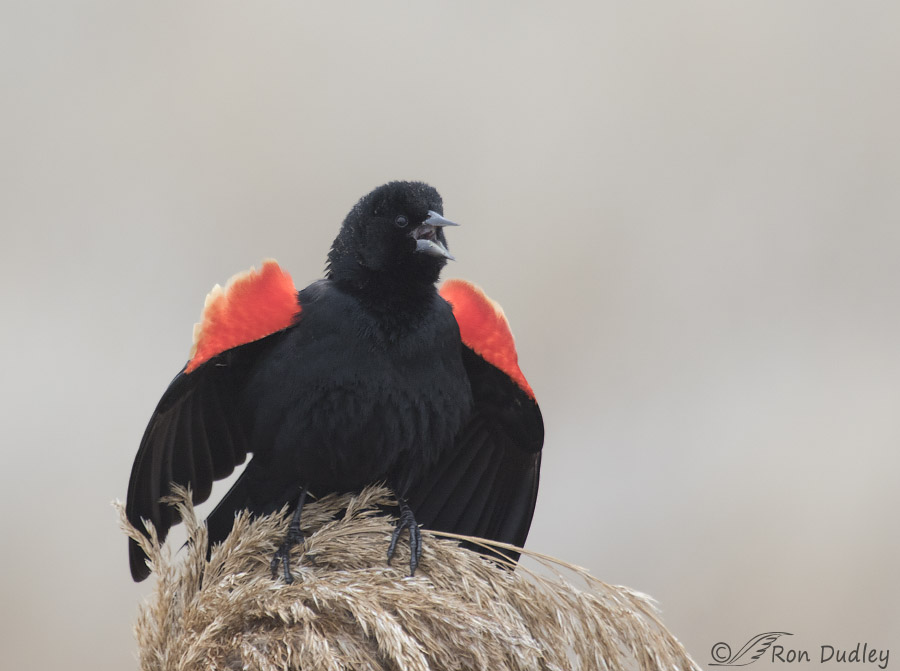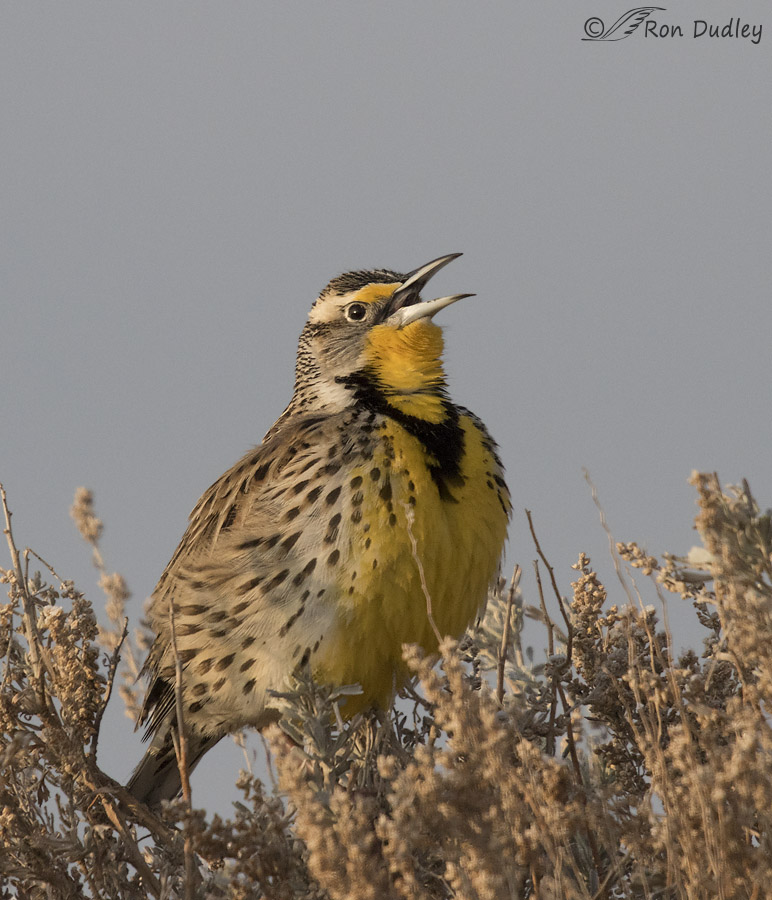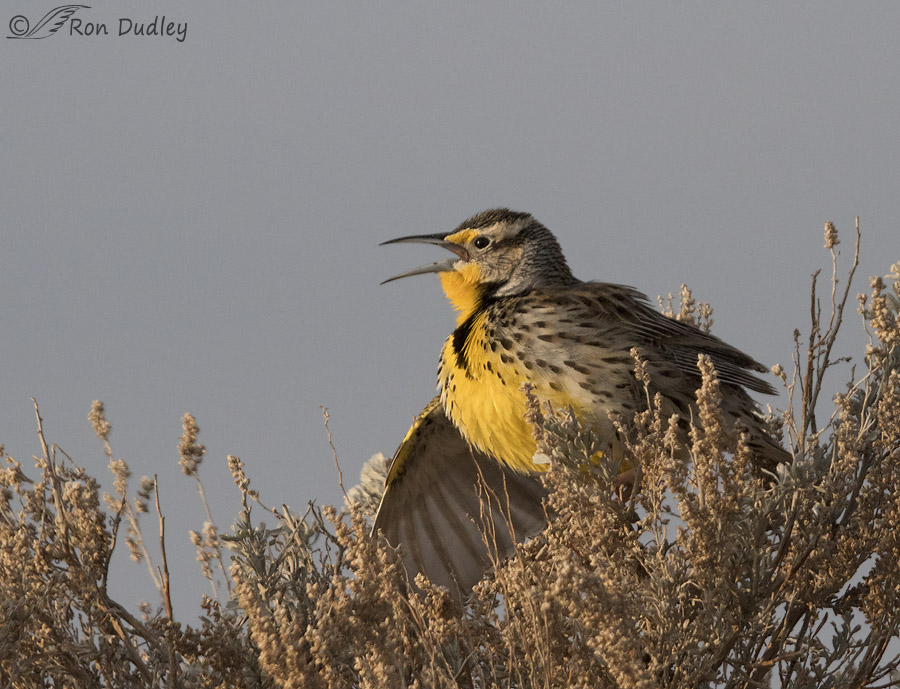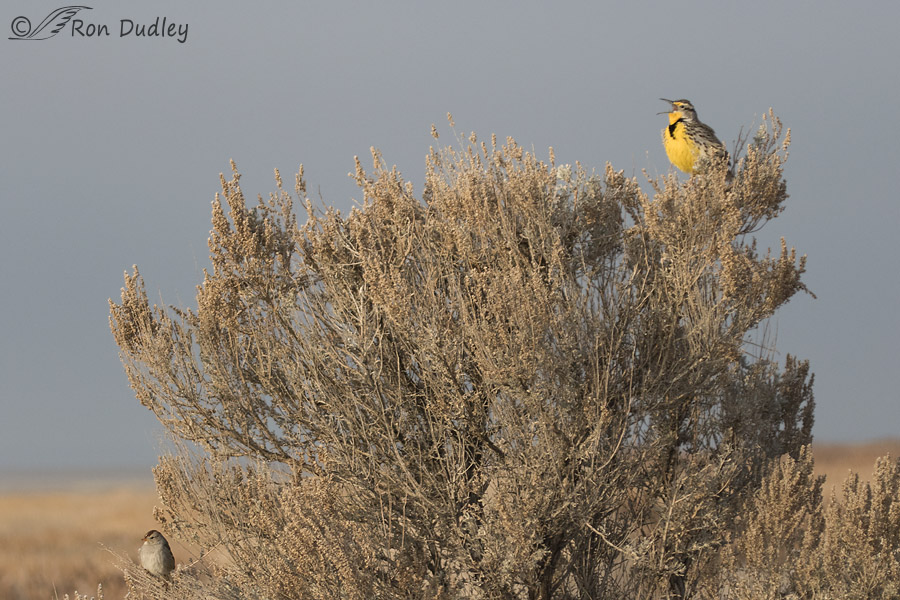Based on what I’m seeing in the field I’m wondering if some birds aren’t being tricked into spring activities too early. Here in northern Utah we’re having yet another unusually warm winter. Temperatures are significantly higher than normal and most of our precipitation in the valleys has been in the form of rain rather than snow. My snow blower remains in the backyard shed, unserviced and unused in the middle of January for the first time I can recall. And at least some of our birds apparently already have already begun responding to springtime hormones and genetic programming.

1/200, f/8, ISO 1000, Canon 7D Mark II, Canon 100-400 @ 400 mm + 1.4 tc, not baited, set up or called in
It isn’t unusual for some of our avian year round residents to sing during winter but when they do their singing seems to lack enthusiasm and they’re quite shy about it and difficult to approach during the process. But in spring when they’re singing on territory they’re much more “sticky” when approached and their enthusiasm for their singing is boundless. That’s what I’m beginning to see now – birds that continue to sing on perch as I approach in my pickup rather than flying off and their singing is animated and fervent. I photographed this male Red-winged Blackbird two days ago in low light as he sang and he didn’t fly off as I approached like they usually do during winter. He held his ground for several minutes, turning on his perch and singing away enthusiastically. Other blackbirds are following suit.

1/2500, f/8, ISO 1600, Canon 7D Mark II, Canon 100-400 @ 320 mm + 1.4 tc, not baited, set up or called in
Yesterday this Western Meadowlark was doing the same thing. Meadowlarks also occasionally sing during winter but not like this. I photographed this bird for quite a while as it sang and it wasn’t about to be pushed off its perch by my presence – it was persistent and enthusiastic in its singing. Until yesterday I hadn’t been able to closely approach a singing meadowlark since last summer.

1/3200, f/7.1, ISO 1600, Canon 7D Mark II, Canon 100-400 @ 240 mm + 1.4 tc, not baited, set up or called in
I’ve spent many hours watching singing meadowlarks through my lens in springtime and when they’re serious about it they just can’t seem to help themselves – the song seems to bubble out of them despite whatever else may be going on. This bird (the same one as in the photo above) even continued to sing during a wing-stretch. I’d swear that the meadowlark thought it was April…

1/2500, f/6.3, ISO 1600, Canon 7D Mark II, Canon 100-400 @ 100 mm + 1.4 tc, not baited, set up or called in
And the meadowlark had company. This juvenile White-crowned Sparrow seemed to enjoy the serenade and stuck around for several minutes as the meadowlark performed. This image is full frame, I was barely able to fit both birds in.
Blackbirds and meadowlarks aren’t the only species that seem to be significantly early in their springtime activities. For the past week I’ve been watching a pair of Red-tailed Hawks at a nest in Farmington. Both birds are often there and sometimes they’re both in the nest when I drive by. I don’t recall ever seeing this activity in red-tails so early in the season. I don’t have any photos to illustrate because the nest is deeply buried in a cottonwood tree.
And there are American Avocets still hanging around the area that have never left for the winter.
My suspicions here about early springtime activities are highly unscientific and anecdotal but what I’m seeing has certainly caught my attention.
When birds nest too early the results can be disastrous.
Ron


Hi Ron, do you know much about Varied Thrush behavior? I had a male in a tree in my neighbor’s tree today (visible from my home office window), and he kept sticking his wings out, much like that Red-Winged Black Bird. I couldn’t tell if he was singing because I was in the house observing this behavior.
I’d have to see the behavior to even make a guess, Kathryn but I’m ignorant of specific Varied Thrush behaviors – they’re rare in my neck of the woods and I’ve never photographed one.
Absolutely sensational shots Ron! I think they’re just happy it’s warm. It’s been Brrrrrr cold in most of the country.
Charlotte
Thanks, Charlotte. I’d love to see some of your cold weather around here.
Global weirding…
Our summer has been unable to make up its mind. It came in hard and early. And flip flops around on an almost daily basis. Fingers/toes and eyes crossed that the birds and the plants survive it.
Obviously if the birds do the opposite of what you tell them – you need to tell them to do the opposite of what you want. Good luck.
Reverse psychology. I should try that, EC…
Maybe the birds are just like us when there’s a nice break in the weather. We get a little “spring” in our step, tend to sing out loud … huh? Am I the only one?
Beautiful photographs no matter what’s causing their behavior!
Could be, Wally. I wondered about that too. But then there’s the nesting behavior of the red-tails… I just don’t know.
Interesting observations Ron and lovely photos. It seems to me that abnormal fluctuations of temperature in the winter are problematic for wildlife and plants and trees. We have an apple orchard at 7000 feet. What I am noticing is that the abnormally warm periods we see in winter the past few years (1 week of 52 deg F highs), followed by cold spells (-5 deg F lows), are actually killing the trees. It used to be that we worried about spring frost and snow destroying the blossoms, now we see lots of tree mortality (the sap rises in the warm spells, then the deep freezes cause cracking).
However, for migratory birds, I have been puzzled on how do the flocks of birds know when to start heading back north (or south)? For example, Sandhill Cranes, that fly long distances. If it is warm winter conditions in the southern part of their migration route, and very cold in the northern part, how do they decide when to fly north? Is it a trial and error method, where some scouts fly north and return, or ?
Curious on your thoughts on this. Thanks!
Ed, It’s my understanding that in many bird species migration is largely cued by photoperiodism (relative length of day and night) more than it is by anything else, like temperature.
Here in the Mid-Columbia, we have had a colder than normal winter which my horses predicted by starting to hair up the 3rd week of August. Right now I have alium up and other bulb plants coming up under the leaves. I look at my horses for winter; the plants for spring. I HOPE spring is coming; alium can survive if it turns cold. Thanks for the fine pictures – as usual!! I look forward each morning for your daily edition.
Interesting about your horses, Karen. I enjoyed this line – “I look at my horses for winter; the plants for spring.” Thank you.
Beautiful–and worrisome–photos . The plants and trees here in southern Utah are exhibiting the same confounding behavior; everything’s several weeks ahead in budding out .Although it’s uplifting for us humans to see , all I can think of are the freezes that are sure to come , and the potential ruination of fruits and seeds that all the critters depend upon . I’m thankful that they can’t “project ahead” and can just power up
and SING with all their little spirits !
That’s scary, Kris. I wonder if some birds actually take cues from plant life about the timing of the season. I have no idea if they do or not – just speculating…
One could comment that Bent’s Life Histories were anecdotal and some of the observations by today’s standards, unscientific, yet all those Bent’s volumes were considered the primary Ornithological books of the time. As a matter of fact, most major ornithological work is based on observation such as yours, and you have actual images and date stamps to back up your observations!!
As the winter moves to spring hormonal activity is developing, quicker in some then in others. As I’m sure you know Red-winged Blackbird males are obsessively territorial and with all your warmish weather that you have been having could actually initiate their singing. I think you are right on!! Here in the east with temperatures going up and down from the 20’s to -20, we could use some of that warmth.
Great images, Ron
Good point about Bent’s, Dick.
I have no idea if I’m right or wrong but I’m pretty darned sure that these behaviors are emerging earlier around here than they used to, whatever the reason.
I hope that they don’t nest too early. Nevertheless, these photos put a song in my heart… thanks for sharing them and see if you can talk some sense into them.
“see if you can talk some sense into them.”
I would if I could, Alison but when I talk to birds they usually do the exact opposite of what I’m asking of them. Dr. Dolittle I’m not…